货币金融学第十一章
米什金《货币金融学》第11章

重点知识1.金融创新有哪些类型?经济环境的变化推动金融机构寻求金融创新。
金融创新的三种基本类型为:①适应需求变化的创新:利率波动性利率风险的上升增加了对能够控制这种风险的金融产品和服务的需求,促进了新金融工具的诞生:可变利率抵押贷款、金融衍生产品。
②适应供给变化的金融创新:信息技术信息技术降低了处理金融交易的成本,提高了金融机构通过为公众创建新金融产品和提供新服务所获取的利润;此外,它使得投资者更容易获取信息,从而为企业发行证券提供了便利。
信息技术的迅速发展导致了很多新金融产品和服务的诞生:银行信用卡和借记卡、电子银行业务、垃圾债券、商业票据市场、证券化。
③规避现行监管的金融创新:主要为了规避两类监管:法定准备金、对存款利息支付的限制。
因此导致了两个重要的金融创新:货币市场共同基金和流动账户。
2.网络银行的发展为何不尽如人意?(第九版)①银行储户希望了解他们的存款是安全的,因此不愿意将自己的钱交给没有长期记录的新机构。
②客户担心在线交易的安全性和私密性。
在私人信息保管方面,一般认为传统银行的安全性更好,信誉更高。
③客户可能愿意接受由有形营业机构所提供的服务。
例如,银行客户更愿意面对面地购买长期储蓄产品。
④网络银行存在一些技术难题,如服务器瘫痪、互联网速度慢与交易操作失误等,随着技术的发展,这些问题可能会逐渐消失。
3.传统银行业务的规模为什么出现萎缩?①资金获取(负债)的成本优势的下降。
在过去根据《Q条例》,对支票存款不得付息,对定期存款支付的最高利率水平只能略高于5%。
而支票存款是银行资金的主要来源于支票存款零利率的规定意味着银行资金成本非常低。
因此,这些限制性政策是有利于银行的。
随着通货膨胀率的上升导致了高利率环境,投资者对不同资产之间的收益率差异更为敏感,结果就是脱媒过程,即人们将资金从银行低利率的支票存款和定期存款账户中提取出来,转而投资于收益率较高的资产。
同时《Q条例》导致了货币市场共同基金的金融创新,从而将银行拖入更为不利的境地。
货币金融学·第十一章 货币制度

3
2016/1/16
20
集美大学财经学院金融系
信用货币制度
货币金融学
2016/1/16
21
集美大学财经学院金融系
纸币本位制
纸币本位制是以中央银行或国家指定机构发行的纸币 作为本位货币的货币制度,纸币本位制又称作信用本位制。
纸币本身并无价值,它之所以能成为本位币其原因在于:
货币金融学
首先,磨损了的铸币还 可在相当时期内继续充 当本位币,商业银行发 行的银行券也可以代表 金银货币在市场上流通
在当代世界各国已无金属货币流通的情况下,黄金准备的后两项 用途已经消失,但黄金作为国际支付的准备金这一作用仍继续存在, 各国也都储备一定量的黄金作为准备。
2016/1/16
9
集美大学财经学院金融系
金属货币制度
货币金融学
2016/1/16
10
集美大学财经学院金融系
银本位
银本位制是以白银为本位货币材料的货币制度。有银 两本位和银币本位两种类型。
货币金融学
目前各国信用货币的发行权都由法律规定集中于中央银行 或指定机构,由国家垄断发行。
2016/1/16
6
集美大学财经学院金融系
货币的流通和支付能力
本位币
非本位币
面值与实际金属价值是 一致的,是足值货币, 各国法律规定,本位币 具有无限法偿能力。
货币金融学
各国一般规定辅币只具 有有限法偿力,但可以 与本位币自由兑换。
货币金融学
2016/1/16
8
集美大学财经学院金融系
准备金制度
黄金储备是准备金制度的重要内容。在金属货币流通 的条件下,黄金储备主要有三项用途:
第一,作为国际支付手段的准备金,也就是作为世界货币的准备金
金融学课件-第十一章PPT课件

通货紧缩指物价水平、货币供应量和经济 增长率三者同时持续下降的经济现象
二、通货紧缩的成因
(一)经济周期因素 (二)经济结构失调 (三)货币因素 (四)技术进步因素 (五)国际市场的影响 (六)心理预期因素
第34页/共38页
三、通货紧缩的危害
• 经济增长率下降,失业增加 • 破坏信用关系 • 影响社会消费和投资 • 加重银行不良资产
(1)紧缩性货币又政称策为。抽紧银根,即中央银行通过减少流通中
货币量的办法,提高货币的购买力,减轻通货膨胀压力。 具体政策工具和措施包括:① 通过公开市场业务出售政府债券;
② 提高贴现率和再贴现率;③ 提高商业银行的法定准备金率。
第26页/共38页
( •
2)紧缩性财政政策。
增加税收 削减政府购买支出 减少政府转移支付支出
第11页/共38页
第二节 通货膨胀
二、通货膨胀的成因与对策
(一)需求拉上型通货膨胀(Demand-Pull Inflation)——过多的货币追逐过少的商品
第12页/共38页
第二节 通货膨胀 (二)成本推进型通货膨胀(Cost-Push
Inflation)
第13页/共38页
第二节 通货膨胀
(三)供求混合推进型通货膨胀(Mixed Inflation)
参考答案:第十一章货币需求

第十一章货币需求一、填空1.流通速度2.商品价格商品价格水平3.资产4.现金交易现金余额5.利率6.预防动机投机动机7.收入利率8.预防性货币需求9.恒久性收入10.物价变动11.机会成本12.保值生利13.规模机会成本二、判断1.错2.对3.对4.错5.错6.对7.对8.对9.对10.错三、单选1.C 2.A四、多选1.ABD 2.BCD 3.AD 4.BCD 5.ABC6.ABCD 7.AB四、问答1.阐明马克思关于流通中货币量的理论。
答:首先,马克思是以完全的金币流通为假设条件。
他的论证是:(1)商品价格取决于商品的价值和黄金的价值,而价值取决于生产过程,所以商品是带着价格进入流通的;(2)商品价格有多大,就需要有多少金来实现它;(3)商品与货币交换后,商品退出流通,金却留在流通之中可以使另外的商品得以出售,从而一定数量的金,流通几次,就可使相应倍数价格的商品出售。
因此,有:执行流通手段职能的货币量=商品价格总额/同名货币的流通次数公式表明,货币量取决于价格的水平、进入流通的商品数量和货币的流通速度三个因素。
马克思在分析这个问题时还有一个极其重要的假设,即在该经济中存在着一个数量足够大的黄金贮藏:流通中需要较多的黄金,金从贮藏中流出,流通中有一些黄金不需要了,多余的金退出流通,转化为贮藏。
也正是由于假设存在这样一个调节器,所以流通需要多少货币,就有多少货币存在于流通之中。
但在实际经济生活中,并不一定必然存在这样的假设条件。
其次,马克思进而分析了纸币流通条件下货币量与价格之间的关系。
他指出,纸币是由金属货币衍生来的。
纸币所以能流通,是由于国家的强力支持。
同时,纸币本身没有价值,只有流通,才能作为金币的代表。
如果说,流通中可以吸收的金量是客观决定的,那么流通中无论有多少纸币也只能代表客观所要求的金量。
也就是说,纸币流通规律与金币流通规律不同:在金币流通条件下,流通所需要的货币数量是由商品价格总额决定的;而在纸币为惟一流通手段的条件下,商品价格水平会随纸币数量的增减而涨跌。
国开作业现代货币金融学说-第十一章 合理预期学派的货币金融学说-章节测验68参考(含答案)
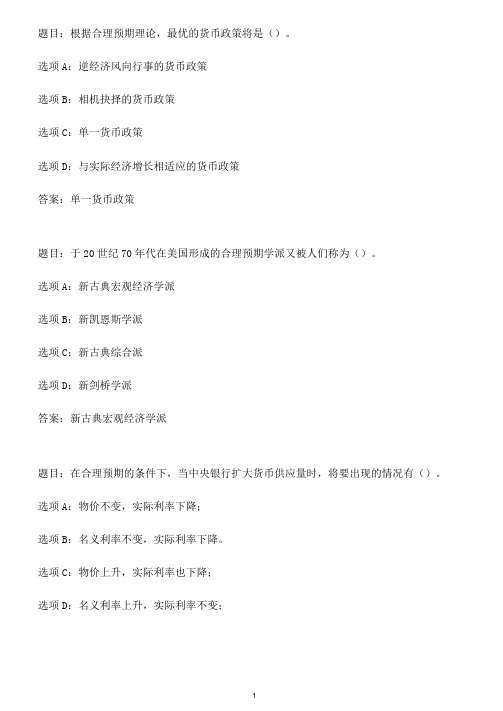
题目:根据合理预期理论,最优的货币政策将是()。
选项A:逆经济风向行事的货币政策
选项B:相机抉择的货币政策
选项C:单一货币政策
选项D:与实际经济增长相适应的货币政策
答案:单一货币政策
题目:于20世纪70年代在美国形成的合理预期学派又被人们称为()。
选项A:新古典宏观经济学派
选项B:新凯恩斯学派
选项C:新古典综合派
选项D:新剑桥学派
答案:新古典宏观经济学派
题目:在合理预期的条件下,当中央银行扩大货币供应量时,将要出现的情况有()。
选项A:物价不变,实际利率下降;
选项B:名义利率不变,实际利率下降。
选项C:物价上升,实际利率也下降;
选项D:名义利率上升,实际利率不变;
答案:名义利率上升,实际利率不变;
题目:合理预期学派货币金融理论的核心和基点是()
选项A:萨伊定律
选项B:合理预期理论
选项C:货币中性论
选项D:菲力普斯曲线
答案:合理预期理论
题目:合理预期学派的通货膨胀理论最大的特点是()
选项A:赞同通货膨胀促进论
选项B:提出了预期通货膨胀论
选项C:强调供给方面的因素
选项D:提出了通货膨胀归根结底是由货币因素造成的
答案:提出了预期通货膨胀论
题目:合理预期学派与货币学派在货币政策主张方面最主要的分歧在于()选项A:货币政策操作工具
选项B:最优货币供应量的确定
选项C:货币政策最终目标
选项D:货币政策中介指针
答案:最优货币供应量的确定。
蒋先玲货币金融学习题册 第十一章 通货膨胀与通货紧缩
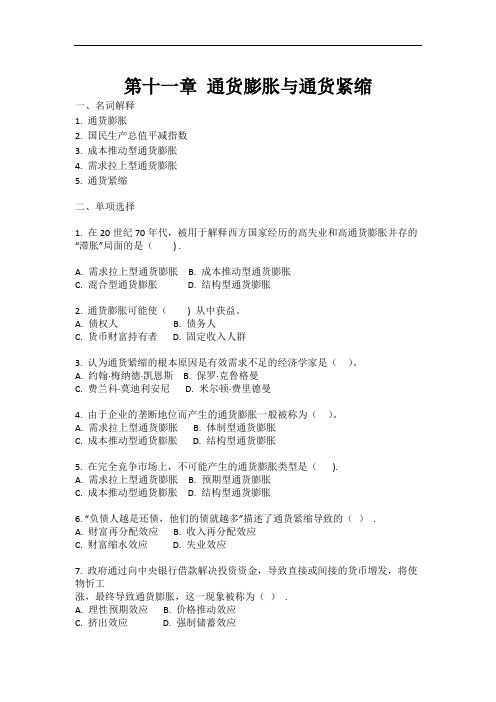
第十一章通货膨胀与通货紧缩一、名词解释1. 通货膨胀2. 国民生产总值平减指数3. 成本推动型通货膨胀4. 需求拉上型通货膨胀5. 通货紧缩二、单项选择1. 在20世纪70年代,被用于解释西方国家经历的高失业和高通货膨胀并存的“滞胀”局面的是() .A. 需求拉上型通货膨胀B. 成本推动型通货膨胀C. 混合型通货膨胀D. 结构型通货膨胀2. 通货膨胀可能使() 从中获益。
A. 债权人B. 债务人C. 货币财富持有者D. 固定收入人群3. 认为通货紧缩的根本原因是有效需求不足的经济学家是()。
A. 约翰·梅纳德·凯恩斯B. 保罗·克鲁格曼C. 费兰科·莫迪利安尼D. 米尔顿·费里德曼4. 由于企业的垄断地位而产生的通货膨胀一般被称为()。
A. 需求拉上型通货膨胀B. 体制型通货膨胀C. 成本推动型通货膨胀D. 结构型通货膨胀5. 在完全竞争市场上,不可能产生的通货膨胀类型是().A. 需求拉上型通货膨胀B. 预期型通货膨胀C. 成本推动型通货膨胀D. 结构型通货膨胀6. “负债人越是还债,他们的债就越多”描述了通货紧缩导致的().A. 财富再分配效应B. 收入再分配效应C. 财富缩水效应D. 失业效应7. 政府通过向中央银行借款解决投资资金,导致直接或间接的货币增发,将使物忻工涨,最终导致通货膨胀,这一现象被称为().A. 理性预期效应B. 价格推动效应C. 挤出效应D. 强制储蓄效应8. 以下社会主体中,由于通货膨胀导致实际收人水平下降的是().A. 股票投资者B. 固定收人者C. 企业主D. 政府9. 根据凯恩斯的“有效需求理论”,有效需求不足会导致物价水平下跌,经济收缩,此时可以通过()来稳定有效需求。
A. 调整国民预期B. 实行宽松的货币政策C. 增加政府支出D. 调整存款准备金率10. 以哈耶克为代表的奥地利学派认为通货紧缩是一种派生过程,() 是造成通货紧缩的主要原因,因而被称为“经济周期”通货理论。
贸大金专每日一个名词解释—监管套利
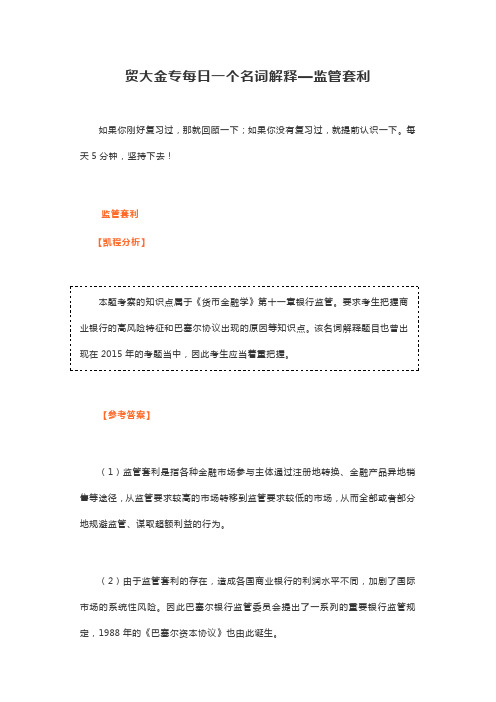
如 果 你 刚 好 复 习 过 ,那 就 回 顾 一 下 ;如 果 你 没 有 复天 5 分钟,坚持下去!
监管套利 【凯程分析】
本题考察的知识点属于《货币金融学》第十一章银行监管。要求考生把握商 业 银 行 的 高 风 险 特 征 和 巴 塞 尔 协 议 出 现 的 原 因 等 知 识 点 。该 名 词 解 释 题 目 也 曾 出 现在 2015 年的考题当中,因此考生应当着重把握。
【参考答案】
(1)监管套利是指各种金融市场参与主体通过注册地转换、金融产品异地销 售 等 途 径 ,从 监 管 要 求 较 高 的 市 场 转 移 到 监 管 要 求 较 低 的 市 场 ,从 而 全 部 或 者 部 分 地规避监管、谋取超额利益的行为。
(2)由于监管套利的存在,造成各国商业银行的利润水平不同,加剧了国际 市场的系统性风险。因此巴塞尔银行监管委员会提出了一系列的重要银行监管规 定,1988 年的《巴塞尔资本协议》也由此诞生。
货币金融学复习大纲(含答案)

2021年上半年学位综合评定考试《货币金融学》课程考试大纲第一章货币与货币制度考点:1.概念:狭义货币、广义货币、货币职能、货币制度、格雷欣法则2.理解:货币制度的构成要素和货币形式的演变与发展第二章金融机构体系概览考点:1.概念:商业银行、金融公司、保险公司、政策性金融机构、开放式基金、封闭式基金2.理解:直接融资的间接融资特点及其区别第三章利息与利率考点:1.概念:利率、基准利率、名义利率、实际利率2.理解:影响利率的主要因素第四章金融市场及其构成考点:1.概念:资本市场、货币市场、金融市场、金融工具、国库券、回购协议、债券2.理解:同业拆借市场、场外交易市场特点、场内交易的特点第五章金融衍生工具市场考点:1.概念:股票价格指数、利率互换、利率期货、期权、欧式期权、远期利率协议2.理解:金融衍生工具的主要种类、概念和特征第六章商业银行及经营管理考点:1.概念:法定存款准备金、商业银行表外业务2.理解:商业银行的储备资产、商业银行的主要职能第七章中央银行考点:1.概念:中央银行、商业银行、准中央银行、基础货币2.理解:中央银行的性质及其基本职能第八章银行监管考点1.概念:银行挤兑、核心资本、市场风险2.掌握:银行监管的主要内容、目的和原则第九章货币政策考点1.概念:货币政策、法定存款准备金率、贴现政策2.理解:货币政策到主要内容、贴现政策的运作机制及优缺点第十章货币供求考点:1.概念:货币需求、货币供给、派生存款、超额准备金第十一章通货膨胀与通货紧缩考点:1.概念:通货膨胀、通货紧缩第十二章开发金融体系概览考点:1.概念:外汇、汇率的标价法、2.理解:国际货币体系的内涵五、考试复习题<<货币金融学>复习题一、单项选择(每题1分,本大题10题,共计10分)1.货币和收入的区别在于()A.货币是指流量而收入是指存量B.货币是指存量而收入是指流量C.两者无区别,都是流量概念D.两者无区别,都是存量概念2.货币的基本职能是()A.价值尺度B.流通手段C.流通手段和支付收到D.价值尺度和流通手段3.根据通用的货币层次划分标准,准货币一般是指()A.M1和M2的差额B.M2和M3的差额C.M1和M3的差额D.以上均不是4. 现代金融经济学认为,金融机构存在最主要因素是()A.柠檬问题B.二手车问题C.搭便车问题D.信息不对称5.在银行体系中,处于主体地位的是()A.中央银行B.专业银行C.商业银行D.投资银行6.降低利率会是企业利润相对()。
戴国强《货币金融学》配套题库-章节题库-金融创新【圣才出品】

第十一章金融创新一、概念题1.电话银行答:电话银行是指利用现代通信手段和数字语言转换技术发展起来的新型银行。
在银行电子计算机联网的营业网点开立账户的客户,在申请后,不论在家里、办公室里或出差在外,只要拨通电话银行的服务专线,即可获得所需信息和服务。
电话银行可以提供信用卡授权、调拨存款、转账、查核账务、存折挂失、更改密码、查询股票交易等服务。
电话银行是当今世界发达国家和地区先进的金融交易工具。
2.金融创新(吉林大学2002研)答:金融创新是指银行和非银行金融机构在其活动中,为生产、发展和迎合客户的需要对各种金融要素实行新的组合而创造的新的金融产品、新的金融交易方式以及新的金融市场和新的金融机构等一系列的变革行为。
其内容包括:(1)金融业务、金融工具的创新;(2)金融服务的创新;(3)金融机构职能与金融市场的创新等。
3.资产证券化(武汉理工大学2004研;吉林大学2003研;东北财大2001研)答:资产证券化指的是通过对流动性差,或者说不能立即变现,但却有稳定的预期收益的资产进行重组,将其转换为可以公开买卖的证券的过程,它是证券化的高级阶段。
按照被证券化的资产种类区分,资产证券化可以被分为实物资产的证券化和金融资产的证券化。
资产证券化的几个关键步骤是:(1)资产的出售,资产出售须以买卖双方已签订的书面资产买卖协议为依据,出售时卖方拥有对标的资产的全部权利,买方要对标的资产支付对价;(2)信用提高,资产证券化需要对资产支持证券进行信用提高,信用提高可以由发起人,也可以由第三方进行;(3)资产证券的信用评级,信用评级由专门评级机构应资产证券发行人或承销人的委托进行。
评级考虑因素不包括由利率变动等因素导致的市场风险,或基础资产提前支付所引起的风险,而主要考虑资产的信用风险;(4)发售证券,经过信用提高和信用评级后,即可通过投资银行发售证券,获取收入,以向发起人支付购买资产的价格。
4.金融中介创新理论答:金融中介创新理论是西方经济学界探讨金融创新原因的理论之一,格利(J.Gurley)和肖(E.Shaw)认为,金融中介是经济增长过程中必不可少的部分,金融创新是企业需求与金融部门提供服务相匹配的结果。
货币金融学第十一章

• 存款保险制度的存在加重了商业银行的道德风险 • 放松管制
– 1980年的《存款机构放松管制和货币控制法》 – 1982年的《存款机构法》
Copyright © 2010 Pearson Addison-Wesley. All rights reserved.
11-15
• 政府安全网的其他形式:
– 中央银行向陷入困境的机构放贷(最后贷款人).
Copyright © 2010 Pearson Addison-Wesley. All rights reserved.
11-2
政府安全网
• 道德风险
– 储户没有太大动机对银行进行市场约束. – 金融机构可能会冒更高的风险.
– – – – 董事会和高级管理层实施监督的质量 对所有具有重大风险的业务活动的政策和限制措施的有效性 风险计量和监督体系的质量 内部控制措施是否得当
• 利率风险上限
– 内部规章制度和流程 – 内部管理和监督 – 压力测试与计算在险价值 (VAR)
Copyright © 2010 Pearson Addison-Wesley. All rights reserved.
Copyright © 2010 Pearson Addison-Wesley. All rights reserved.
11-23
11-17
表2 一些国家或地区救助银行的成本
Copyright © 2010 Pearson Addison-Wesley. All rights reserved.
11-18
次贷危机后的金融监管将往何处去?
• 监管肯定会着眼于限制代理问题,提高发起—分销 模式和金融体系的运作效率 • 强化对抵押经纪人的监管
《货币金融学》课程教学大纲
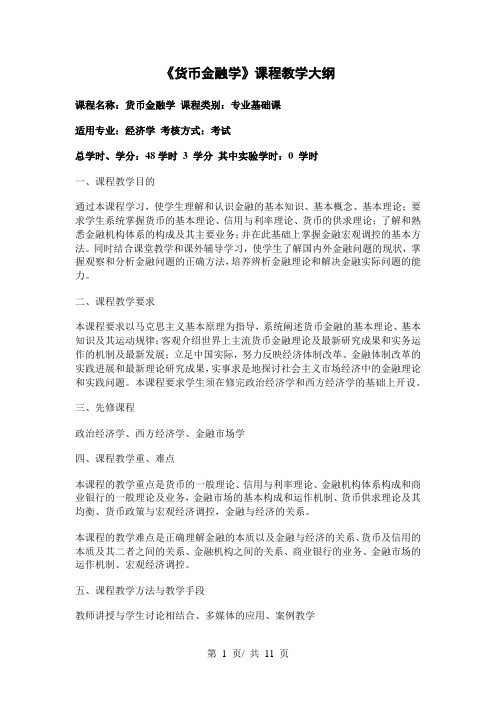
《货币金融学》课程教学大纲课程名称:货币金融学课程类别:专业基础课适用专业:经济学考核方式:考试总学时、学分:48学时 3 学分其中实验学时:0 学时一、课程教学目的通过本课程学习,使学生理解和认识金融的基本知识、基本概念、基本理论;要求学生系统掌握货币的基本理论、信用与利率理论、货币的供求理论;了解和熟悉金融机构体系的构成及其主要业务;并在此基础上掌握金融宏观调控的基本方法。
同时结合课堂教学和课外辅导学习,使学生了解国内外金融问题的现状,掌握观察和分析金融问题的正确方法,培养辨析金融理论和解决金融实际问题的能力。
二、课程教学要求本课程要求以马克思主义基本原理为指导,系统阐述货币金融的基本理论、基本知识及其运动规律;客观介绍世界上主流货币金融理论及最新研究成果和实务运作的机制及最新发展;立足中国实际,努力反映经济体制改革、金融体制改革的实践进展和最新理论研究成果,实事求是地探讨社会主义市场经济中的金融理论和实践问题。
本课程要求学生须在修完政治经济学和西方经济学的基础上开设。
三、先修课程政治经济学、西方经济学、金融市场学四、课程教学重、难点本课程的教学重点是货币的一般理论、信用与利率理论、金融机构体系构成和商业银行的一般理论及业务,金融市场的基本构成和运作机制、货币供求理论及其均衡、货币政策与宏观经济调控,金融与经济的关系。
本课程的教学难点是正确理解金融的本质以及金融与经济的关系、货币及信用的本质及其二者之间的关系、金融机构之间的关系、商业银行的业务、金融市场的运作机制、宏观经济调控。
五、课程教学方法与教学手段教师讲授与学生讨论相结合、多媒体的应用、案例教学六、课程教学内容第一章货币与货币制度(3学时)1.教学内容(1)货币产生与发展(2)货币的本质和职能(3)货币制度的演变2.重、难点提示(1)教学重点:货币在经济中发挥着价值尺度、流通手段、支付手段和价值储藏手段的职能作用;不同职能的特点;货币形式;货币制度的演进(2)教学难点:货币的流通手段与支付手段的区别;货币形式第二章国际货币体系与汇率制度(2学时)1.教学内容(1)国际货币体系(2)外汇与外汇管理(3)汇率制度(4)汇率的分类(5)汇率的标价方式2.重、难点提示(1)教学重点:国际货币制度的演变及主要内容;外汇管理体制;汇率制度;汇率的标价方式(2)教学难点:国际货币制度的演变;汇率的标价方式第三章信用与信用形式(3学时)1.教学内容(1)信用的含义及其构成要素(2)信用与货币的联系(3)现代信用活动的基础(4)现代信用的形式以及各种形式的特点及其之间的关系2.重、难点提示(1)教学重点:信用的特征;信用与货币的关系;现代信用形式(2)教学难点:信用与货币的关系;现代信用形式:商业信用、银行信用、国家信用、消费信用的特点及其关系第四章利率及其决定(3学时)1.教学内容(1)利息(2)利率的种类(3)利率的决定及影响因素(4)利率的作用(4)利率的度量(5)利率的风险结构及期限结构2.重、难点提示(1)教学重点:利息的实质;利率的种类;利率决定理论;利率的计算;(2)教学难点:利息的实质;利率决定理论中的古典学派的储蓄投资理论;利率的计算;影响利率的因素;利率的风险结构及期限结构第五章金融范畴的形成与发展(0.5学时)1.教学内容(1)金融及其涵盖的领域(2)金融范畴的形成(3)金融范畴的界定2.重、难点提示现代银行的产生与金融范畴的形成第六章金融中介体系(2学时)1.教学内容(1)金融中介及其包括的范围(2)西方国家的金融中介体系(3)中国的金融中介体系(4)国际金融机构体系2.重、难点提示(1)教学重点:金融服务业与一般产业的异同;我国目前金融中介体系构成;国际主要金融机构(2)教学难点:金融服务业与一般产业的异同;西方国家金融中介体系的构成;国际主要金融机构:亚投行第七章存款货币银行(4学时)1.教学内容(1)存款货币银行的产生和发展(2)分业经营与混业经营(3)不良债权(4)商业银行的负债业务(5)商业银行的资产业务(6)商业银行的中间业务和表外业务(7)商业银行的经营原则与管理2.重、难点提示(1)教学重点:商业银行的作用;不良债权;商业银行的主要资产业务;中西方商业银行中间业务和表外业务的发展;商业银行的经营原则(2)教学难点:商业银行的作用之“存款货币创造”;不良债权;商业银行的主要资产业务;中西方商业银行中间业务和表外业务的发展;第八章中央银行与金融基础设施(4学时)1.教学内容(1)中央银行的产生及类型(2)中央银行的业务(3)中央银行的职能(4)中央银行的独立性问题(5)中央银行体制下的支付清算体系2.重、难点提示:(1)教学重点:中央银行的职能;中央银行的负债业务;中央银行体制下的支付清算体系;中央银行的独立性问题(2)教学难点:中央银行的职能;中央银行的负债业务;中央银行体制下的支付清算体系;第九章金融市场(3学时)1.教学内容(1)金融市场及其要素(2)货币市场(3)资本市场(4)衍生工具市场(5)投资基金(6)外汇市场与黄金市场2.重、难点提示(1)教学重点:金融市场的主要分类方法及其分类;资本市场的主要子市场:股票市场与长期债券市场;一级市场和二级市场的不同功能及其运作原理;衍生工具市场的主要功能及其特点(2)教学难点:资本市场的主要子市场:股票市场与长期债券市场;一级市场和二级市场的不同功能及其运作原理;衍生工具市场的主要功能及其特点第十章资产组合、资产定价与资本结构(2学时)1.教学内容(1)风险与资产组合(2)证券价值评估(3)资产定价模型(4)资本结构2.重、难点提示(1)教学重点:风险的度量;资本资产定价模型(2)教学难点:风险的度量;资本资产定价模型第十一章金融体系结构(0.5学时)1.教学内容(1)金融体系与金融功能(2)金融体系的两种结构(3)金融体系结构的演进趋势2.重、难点提示:金融体系与金融功能第十二章现代货币的创造机制(4学时)1.教学内容(1)现代的货币都是信用货币(2)存款货币的创造(3)中央银行体制下的货币创造过程2.重、难点提示(1)教学重点:现代金融体制下的存款货币创造;存款货币创造的乘数;基础货币与原始存款的关系;原始存款和派生存款的关系。
贸大金专 名词解释—影子银行
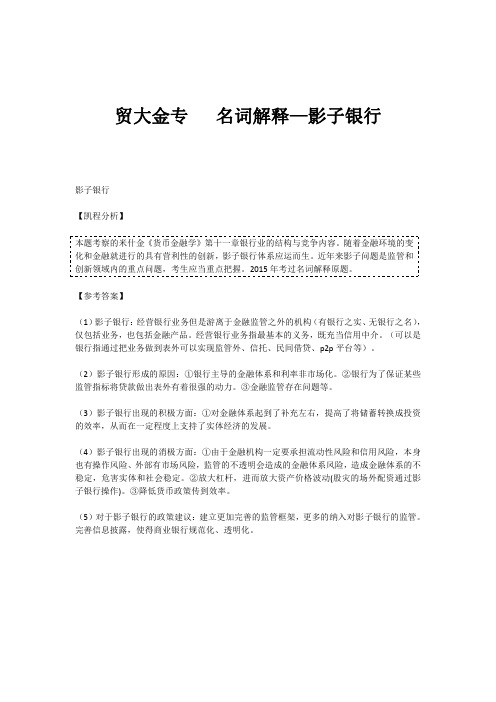
贸大金专名词解释—影子银行
影子银行
【凯程分析】
【参考答案】
(1)影子银行:经营银行业务但是游离于金融监管之外的机构(有银行之实、无银行之名),仅包括业务,也包括金融产品。
经营银行业务指最基本的义务,既充当信用中介。
(可以是银行指通过把业务做到表外可以实现监管外、信托、民间借贷、p2p平台等)。
(2)影子银行形成的原因:①银行主导的金融体系和利率非市场化。
②银行为了保证某些监管指标将贷款做出表外有着很强的动力。
③金融监管存在问题等。
(3)影子银行出现的积极方面:①对金融体系起到了补充左右,提高了将储蓄转换成投资的效率,从而在一定程度上支持了实体经济的发展。
(4)影子银行出现的消极方面:①由于金融机构一定要承担流动性风险和信用风险,本身也有操作风险、外部有市场风险,监管的不透明会造成的金融体系风险,造成金融体系的不稳定,危害实体和社会稳定。
②放大杠杆,进而放大资产价格波动(股灾的场外配资通过影子银行操作)。
③降低货币政策传到效率。
(5)对于影子银行的政策建议:建立更加完善的监管框架,更多的纳入对影子银行的监管。
完善信息披露,使得商业银行规范化、透明化。
货币金融学

货币金融学 Prepared on 22 November 20201货币制度:又称币制,是一国以法律形式确定的该国货币流通的结构、体系与组织形式。
2金银复本位制:当政府明确金银都是法定币材。
(没划)3无限法偿:不论支付数额多大,不论属于何种性质的支付,对方都不能拒绝接受。
(没划)4有限法偿:在一次支付行为中,超过一定的金额,收款人有权拒收;在法定限额内,拒收则不受法律保护。
(没划)5格雷欣法则:在实行金银复本位制条件下,金银有一定的兑换比率,当金银的市场比价与法定比价不一致时,市场比价比法定比价高的金属货币(良币)将逐渐减少,而市场比价比法定比价低的金属货币(劣币)将逐渐增加,形成良币退藏,劣币充斥的现象。
(劣币驱良币)6商业信用:工商企业以赊销方式对购买商品的工商企业所提供的信用。
7消费信用:对消费者个人提供的,用以满足其消费方面所需货币的信用。
(没划)8银行信用:指银行等金融机构以存放款等多种业务形式提供的货币形态的信用。
(没划)9直接融资:直接在最终投资人和最终筹资人之间转移的融资活动10间接融资:资金通过中介机构实现在最终投资人和最终筹资人之间的转移的融资活动。
简答题:1货币制度的主要内容货币制度是国家以法律形式规定的本国货币的流通结构和组织形式,它由国家有关货币方面的法令、条例等综合构成。
货币政策的内容一般有:1币材的确定2确定货币单位3规定流通中货币种类4规定货币铸造和发行的流通程序5对货币法定支付偿还能力的规定6货币发行准备制度的规定2金融市场的构成要素有哪些交易的价格—利率交易的对象—货币资金交易的工具—信用工具或金融工具、金融产品交易的主体—居民个人、企业、金融机构、政府交易的组织方式—交易所交易组织方式、柜台交易组织、中介交易组织方式交易的方式—现货交易、期货交易、期权交易、信用交易1期权合约:是指期权的买方有权在约定的时间或约定的时间期内的时期内,按照约定的价格买进或卖出一定数量的相关资产,也可以根据需要放弃行使这一权利。
(完整版)货币金融学复习要点
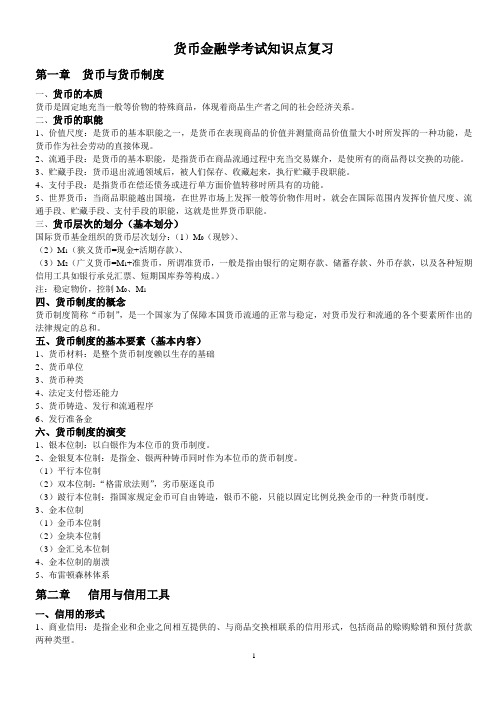
货币金融学考试知识点复习第一章货币与货币制度一、货币的本质货币是固定地充当一般等价物的特殊商品,体现着商品生产者之间的社会经济关系。
二、货币的职能1、价值尺度:是货币的基本职能之一,是货币在表现商品的价值并测量商品价值量大小时所发挥的一种功能,是货币作为社会劳动的直接体现。
2、流通手段:是货币的基本职能,是指货币在商品流通过程中充当交易媒介,是使所有的商品得以交换的功能。
3、贮藏手段:货币退出流通领域后,被人们保存、收藏起来,执行贮藏手段职能。
4、支付手段:是指货币在偿还债务或进行单方面价值转移时所具有的功能。
5、世界货币:当商品职能越出国境,在世界市场上发挥一般等价物作用时,就会在国际范围内发挥价值尺度、流通手段、贮藏手段、支付手段的职能,这就是世界货币职能。
三、货币层次的划分(基本划分)国际货币基金组织的货币层次划分:(1)M0(现钞)、(2)M1(狭义货币=现金+活期存款)、(3)M2(广义货币=M1+准货币,所谓准货币,一般是指由银行的定期存款、储蓄存款、外币存款,以及各种短期信用工具如银行承兑汇票、短期国库券等构成。
)注:稳定物价,控制M0、M1四、货币制度的概念货币制度简称“币制”,是一个国家为了保障本国货币流通的正常与稳定,对货币发行和流通的各个要素所作出的法律规定的总和。
五、货币制度的基本要素(基本内容)1、货币材料:是整个货币制度赖以生存的基础2、货币单位3、货币种类4、法定支付偿还能力5、货币铸造、发行和流通程序6、发行准备金六、货币制度的演变1、银本位制:以白银作为本位币的货币制度。
2、金银复本位制:是指金、银两种铸币同时作为本位币的货币制度。
(1)平行本位制(2)双本位制:“格雷欣法则”,劣币驱逐良币(3)跛行本位制:指国家规定金币可自由铸造,银币不能,只能以固定比例兑换金币的一种货币制度。
3、金本位制(1)金币本位制(2)金块本位制(3)金汇兑本位制4、金本位制的崩溃5、布雷顿森林体系第二章信用与信用工具一、信用的形式1、商业信用:是指企业和企业之间相互提供的、与商品交换相联系的信用形式,包括商品的赊购赊销和预付货款两种类型。
米什金《货币金融学》笔记和课后习题详解(银行业:结构与竞争)【圣才出品】

第11章银行业:结构与竞争11.1 复习笔记1.银行体系的历史发展美国在历史上形成了国民银行和州银行并存的双重银行体系,这两类商业银行的审批机构是不同的,国民银行的设立必须经过财政部的通货监理署特许,州银行则须经州银行委员会特许。
筹组银行的人必须向这些机构提交申请,说明他们计划如何去经营银行。
这些机构则通过对银行管理人员资格、注册资本以及可能获得的收益进行审查来决定是否批准他们的申请并授予营业执照。
众多机构同时监管商业银行:通货监理署、联邦储备系统、联邦存款保险公司和各州的银行管理机构。
2.金融创新与“影子银行体系”的发展(1)金融创新的原因金融环境的变化会推动金融机构进行具有盈利性的创新。
新的产品和服务的研究和开发的过程被称为金融工程。
金融创新按其产生的原因可以分为三种:适应需求变化的创新、适应供给变化的创新和规避管制的创新。
①适应需求变化的创新:利率波动性近年来,利率波动性日益增强,这引起了利率风险水平的上升,从而增加了对能够控制利率风险的金融产品和服务的需求。
金融机构为应付这种新需求,促进了可变利率抵押贷款和金融衍生工具的相继诞生。
②适应供给变化的金融创新:信息技术计算机和通信技术的发展是推动金融创新的最重要的供给变化。
信息技术的影响体现在两个方面:首先,它降低了处理金融交易的成本,提高了金融机构通过为公众开发新金融产品和提供新服务所获取的利润;其次,它使得投资者更容易获取信息,从而为企业发行证券提供了便利。
信息技术的迅速发展导致了很多新金融产品和服务的诞生。
适应供给变化的金融创新有:银行信用卡和借记卡、电子银行业务、垃圾债券、商业票据市场以及证券化等。
③规避现行监管的金融创新两类监管制度严格限制了银行的盈利能力:一是强制银行将一定比例的存款作为准备金的法定准备金制度,法定准备金事实上是对存款的征税,持有准备金的机会成本就是银行将这些准备金贷放出去可能获取的利息;二是对存款利率上限的规定,即《Q条例》,这导致了存款的流失,即脱媒。
11第十一章-通货膨胀与通货紧缩(货币金融学(蒋先玲编著)第3版ppt课件可编辑)精选全文

三、通货紧缩的影响
正效应:持续的物价下跌和低利率使实际货币购买力提高 负面影响:
➢财富缩水效应:使微观主体的财富缩小 ➢经济衰退效应:物价持续、普遍下跌→企业利润减少→减少生产/停产→抑制经济增长 ➢财富分配效应:实际利率提高→加重还款负担→社会财富从债务人向债权人转移 ➢失业效应:通货紧缩导致失业上升
二、成本推动型通货膨胀
➢指在总需求不变的情况下,由生产要素价格上涨引起生产成本上升 所导致的物价总水平持续上涨的情况(成本上升引起了总供给曲线的上移)
二、成本推动型通货膨胀
(一)成本推动型通货膨胀的类型 1.工资推动型通货膨胀
➢过度的工资上涨导致生产成本上升,从而推动总供给曲线上移而形成的(工会组织迫使厂商 提高工资)
➢SS表示供给曲线;D0D0、D1D1、D2D2表示不断提高的需求曲线;FF表示相对不变的总产量 线。Rin表示通货膨胀率,e表示不同水平的均衡点
一、需求拉上型通货膨胀
(三)需求拉上型通货膨胀的运行过程——长期分析
➢在离增长极限点较远时,Ms>Y*>Rin,随着Y*不断接近增长极限点,Ms>Rin>Y*,而且Y* 趋近于零增长,此时,过度需求拉动物价水平迅速上升
第十一章 通货膨胀与通货紧缩
学习目标
1、了解通货膨胀的成因与类型 2、理解通货膨胀的经济效应 3、掌握通货紧缩的成因 4、描述通货紧缩的影响 5、掌握通货膨胀与通货紧缩的治理
第一节 通货膨胀的定义及其度量
一、通货膨胀的定义
通货膨胀,通常是指在一定时间内一般物价水平持续和较明显的上涨 ➢ 是“一般物价水平”的上涨
米什金《货币金融学》第十一版-名词解释
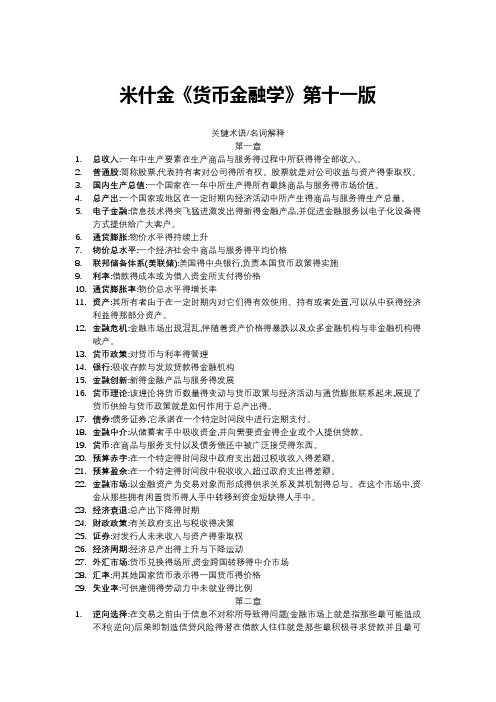
米什金《货币金融学》第十一版关键术语/名词解释第一章1.总收入:一年中生产要素在生产商品与服务得过程中所获得得全部收入。
2.普通股:简称股票,代表持有者对公司得所有权。
股票就是对公司收益与资产得索取权。
3.国内生产总值:一个国家在一年中所生产得所有最终商品与服务得市场价值。
4.总产出:一个国家或地区在一定时期内经济活动中所产生得商品与服务得生产总量。
5.电子金融:信息技术得突飞猛进激发出得新得金融产品,并促进金融服务以电子化设备得方式提供给广大客户。
6.通货膨胀:物价水平得持续上升7.物价总水平:一个经济社会中商品与服务得平均价格8.联邦储备体系(美联储):美国得中央银行,负责本国货币政策得实施9.利率:借款得成本或为借入资金所支付得价格10.通货膨胀率:物价总水平得增长率11.资产:其所有者由于在一定时期内对它们得有效使用、持有或者处置,可以从中获得经济利益得那部分资产。
12.金融危机:金融市场出现混乱,伴随着资产价格得暴跌以及众多金融机构与非金融机构得破产。
13.货币政策:对货币与利率得管理14.银行:吸收存款与发放贷款得金融机构15.金融创新:新得金融产品与服务得发展16.货币理论:该理论将货币数量得变动与货币政策与经济活动与通货膨胀联系起来,展现了货币供给与货币政策就是如何作用于总产出得。
17.债券:债务证券,它承诺在一个特定时间段中进行定期支付。
18.金融中介:从储蓄者手中吸收资金,并向需要资金得企业或个人提供贷款。
19.货币:在商品与服务支付以及债务偿还中被广泛接受得东西。
20.预算赤字:在一个特定得时间段中政府支出超过税收收入得差额。
21.预算盈余:在一个特定得时间段中税收收入超过政府支出得差额。
22.金融市场:以金融资产为交易对象而形成得供求关系及其机制得总与。
在这个市场中,资金从那些拥有闲置货币得人手中转移到资金短缺得人手中。
23.经济衰退:总产出下降得时期24.财政政策:有关政府支出与税收得决策25.证券:对发行人未来收入与资产得索取权26.经济周期:经济总产出得上升与下降运动27.外汇市场:货币兑换得场所,资金跨国转移得中介市场28.汇率:用其她国家货币表示得一国货币得价格29.失业率:可供雇佣得劳动力中未就业得比例第二章1.逆向选择:在交易之前由于信息不对称所导致得问题(金融市场上就是指那些最可能造成不利(逆向)后果即制造信贷风险得潜在借款人往往就是那些最积极寻求贷款并且最可能获取贷款得人)。
- 1、下载文档前请自行甄别文档内容的完整性,平台不提供额外的编辑、内容补充、找答案等附加服务。
- 2、"仅部分预览"的文档,不可在线预览部分如存在完整性等问题,可反馈申请退款(可完整预览的文档不适用该条件!)。
- 3、如文档侵犯您的权益,请联系客服反馈,我们会尽快为您处理(人工客服工作时间:9:00-18:30)。
11-17
• Filing periodic ‗call reports‘
11-4
Asymmetric Information and Bank Regulation: Government Safety Net
• Bank panics and the need for deposit insurance: • Bank failure (in which a bank is unable to meet its obligations to pay its depositors and other creditors and so must go out of business)
Here we also use our economic analysis of financial regulation to explain the worldwide crises in banking and to consider how the regulatory system can be reformed to prevent future disasters .
11-5
Government Safety Net
• Moral Hazard
– Depositors do not impose discipline of marketplace. – Financial institutions have an incentive to take on greater risk.
Assessment of Risk Management
• Greater emphasis on evaluating soundness of management processes for controlling risk • Trading Activities Manual of 1994 for risk management rating based on
• Government provides guarantees of repayment to large uninsured creditors of the largest financial institutions even when they are not entitled tБайду номын сангаас this guarantee • Uses the purchase and assumption method • Increases moral hazard incentives for big banks
– FDIC: short circuits bank failures and contagion effect. – Payoff method. – Purchase and assumption method (typically more costly for the FDIC). • Other form of government safety net: – Lending from the central bank to troubled institutions (lender of last resort).
11-10
《巴塞尔协议》
• 《巴塞尔协议》是国际清算银行(BIS)的巴塞尔 银行业条例和监督委员会的常设委员会———―巴塞 尔委员会”于1988年7月在瑞士的巴塞尔通过的 “关于统一国际银行的资本计算和资本标准的协议” 的简称。该协议第一次建立了一套完整的国际通用 的、以加权方式衡量表内与表外风险的资本充足率 标准,有效地扼制了与债务危机有关的国际风险。
– Quality of – Adequacy – Quality of systems – Adequacy oversight provided of policies and limits for all risky activities the risk measurement and monitoring of internal controls
11-13
商业银行资本管理办法
• 《商业银行资本管理办法(试行)》经中国银监会 第115次主席会议通过,2012年6月7日中国银行业 监督管理委员会令2012年第1号公布。该《办法》 分总则、资本充足率计算和监管要求、资本定义、 信用风险加权资产计量、市场风险加权资产计量、 操作风险加权资产计量、商业银行内部资本充足评 估程序、监督检查、信息披露、附则10章180条, 自2013年1月1日起施行。
11-14
• 金融危机以来,巴塞尔银行监管委员会积极推进国 际金融监管体系改革,并出台了第三版巴塞尔协议 (巴塞尔III),确立了银行业资本和流动性监管的 新标准,要求各成员国从2013年开始实施,2019 年前全面达标。在此背景下,中国银监会于2012年 6月7日发布了新的《商业银行资本管理办法(试 行)》(以下简称“新办法”),此办法将于2013 年1月1日起实施。此办法中对资本定义更加严格, 并扩大了风险资本的覆盖范围,对于增强银行体系 稳健性、引导银行转变发展方式以及促进实体经济 信贷都将起到积极作用
为存款人建立政府安全网, 有效抑制银行挤兑和银行恐 慌现象发生。
11-3
安全网的一种具体形式是存款保险制度 联邦 存款 保险 公司 1.偿付法(Payoff method) 2.收购和接管法 (Purchase and assumption method )
处理
破产 银行
政府存款保险制度在世界范围内的 普及:这是好事吗?
11-16
Financial Supervision: Chartering and Examination
• Chartering 注册(screening of proposals to open new financial institutions) to prevent adverse selection • Examinations (scheduled and unscheduled) to monitor capital requirements and restrictions on asset holding to prevent moral hazard
• Adverse Selection
– Risk-lovers find banking attractive. – Depositors have little reason to monitor financial institutions.
11-6
Government Safety Net:Too Big to Fail
11-11
巴塞尔协议III
• • • • • • • • 商业银行的核心资本充足率将由目前的4%上调到6% 核心资本充足率的要求可达到8.5%-11% 总资本充足率要求仍维持8%不变 还引入杠杆比率、流动杠杆比率和净稳定资金来源比率的要 求,以降低银行系统的流动性风险 加强抵御金融风险的能力 新协议将普通股权益/风险资产比率的要求由原来的2%提高 到4.5% 核心资本充足率的要求也由4%提高到6% 加上2.5%的防护缓冲资本,核心资本充足率的要求达到 8.5%。
11-2
Asymmetric Information and Bank Regulation: Government Safety Net
银行破产,存款人收回的资金可能 仅仅是其存款价值的一部分。 存款人缺乏关于银行 资产质量的信息 传染效应 银行 恐慌
1934年 联邦存 款保险 公司成 立之前
成立后
结果:大型和相互关联的金融机构更加愿意从事高 风险的业务活动,加大了金融危机爆发的可能性。
11-8
Government Safety Net: Financial Consolidation
• Larger and more complex financial organizations challenge regulation – Increased ―too big to fail‖ problem – Extends safety net to new activities, increasing incentives for risk taking in these areas (as has occurred during the subprime financial crisis in 2007-2008).
11-7
Government Safety Net:Too Big to Fail
• 太大而不能倒闭 • 由政府安全网和防止金融机构破产的意愿所产生的道德风险 问题,使金融监管者陷入进退两难的困境。
政府向那些最 大银行中没有 投保的大额债 权人提供还款 保证 增强了大银行的道德风险动机, 大银行冒更大的风险,从而加 大了其发生倒闭的可能性 提高了那些在政府安全网保护 下的非银行金融机构的道德风 险动力
11-15
Prompt Corrective Action
• There are two serious problems. • 1.The bank is more likely to fail because it has a smaller capital cushion if it suffers loan losses or other asset write-downs. • 2.With less capital, a financial institution has less "skin in the game" and is therefore more likely to take on excessive risks. 1 资本 充裕 2 资本 充足 3 资本 不足 纠正行动 4 资本严 重不足 5 资本极 度不足 关闭银行
